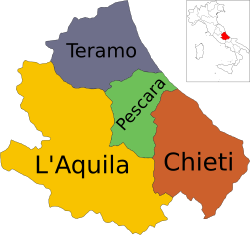Neutrino research
Since late August 2006, CERN has directed a beam of muon neutrinos from the CERN SPS accelerator to the Gran Sasso lab, 730 km away, where they are detected by the OPERA and ICARUS detectors, in a study of neutrino oscillations that will improve on the results of the Fermilab to MINOS experiment.
In May 2010, Lucia Votano, Director of the Gran Sasso laboratories, announced, "The OPERA experiment has reached its first goal: the detection of a tau neutrino obtained from the transformation of a muon neutrino, which occurred during the journey from Geneva to the Gran Sasso Laboratory." [3] This was the first observed tau neutrino candidate event in a muon neutrino beam, providing further evidence that neutrinos have mass. [4] (Research first determined that neutrinos have mass in 1998 at the Super-Kamiokande neutrino detector. [5] [6] ) Neutrinos must have mass for this transformation to occur; this is a deviation from the classic Standard Model of particle physics, which assumed that neutrinos are massless. [6] [7]
An effort to determine the Majorana/Dirac nature of the neutrino, called CUORE (Cryogenic Underground Observatory for Rare Events), is operating in the laboratory (as of 2018). The detector is shielded with lead recovered from an ancient Roman shipwreck, due to the ancient lead's lower radioactivity than recently minted lead. The artifacts were given to CUORE from the National Archaeological Museum in Cagliari. [8]
In September 2011, Dario Autiero, a researcher of Institute of Nuclear Physics in Lyon, France, presented preliminary findings that indicated neutrinos produced at CERN were arriving at OPERA detector about 60 ns earlier than they would if they were travelling at the speed of light. [9] This faster-than-light neutrino anomaly was not immediately explained. [10] The results were subsequently investigated and confirmed to be wrong. They were caused by a flawed optic fiber cable in OPERA receiver of the laboratory, [11] resulting in late arrival of the clock signal to which the neutrinos' arrivals were compared. Although the official statement published by OPERA does not declare any anomaly in the velocity of the neutrinos, [12] and therefore the case is completely solved, the development of the story has given the community pause for thought.
In 2014 Borexino measured directly, for the first time, the neutrinos from the primary proton-proton fusion process in the Sun. This result is published on Nature. This measurement is consistent with the expectations derived from the standard solar model of J. Bahcall along with the theory of solar neutrino oscillations as described by MSW theory. In 2020 Borexino measured also solar neutrinos originated from CNO cycle, a fusion process common in giant stars but uncommon in the Sun (only 1% of Sun's energy output). [13] With this outcome Borexino has unraveled both the two processes powering the Sun and many main sequence stars.



